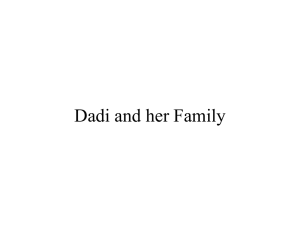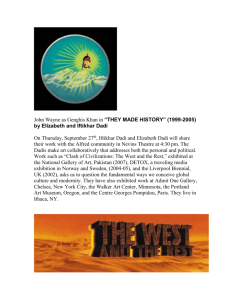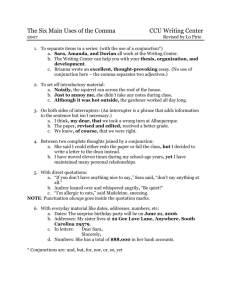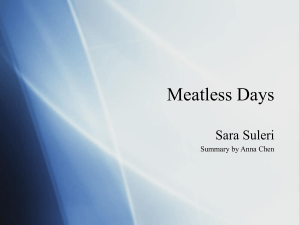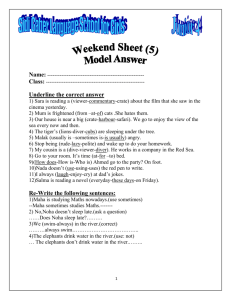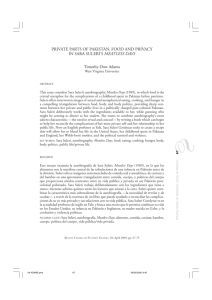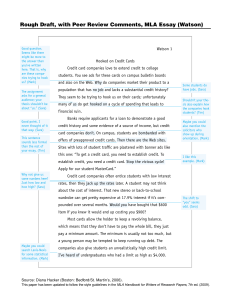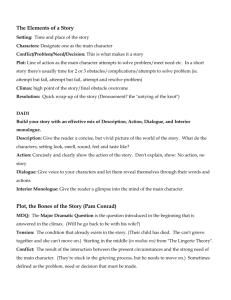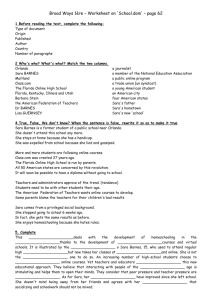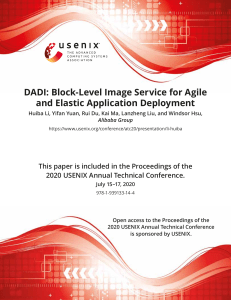Meatless Days (1)
advertisement
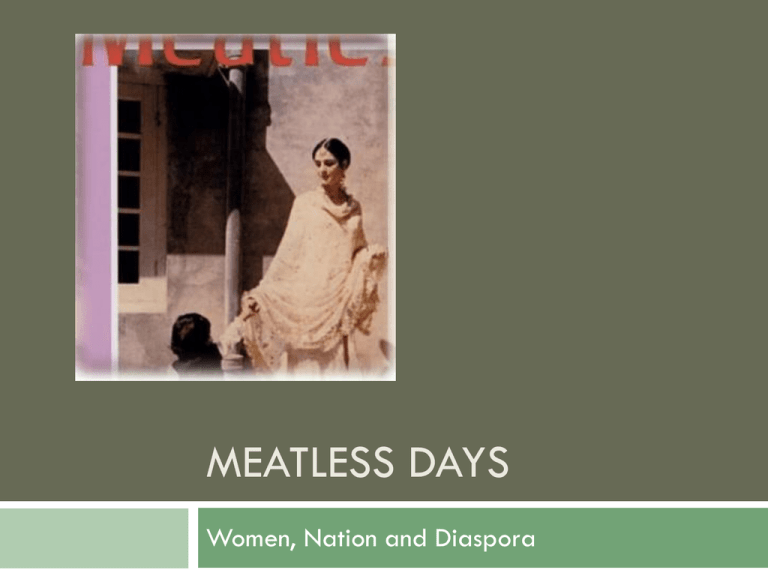
MEATLESS DAYS Women, Nation and Diaspora Outline Diaspora aesthetic: 1) associational; 2) images of fluidity (fluid among different semantic levels) and loss Women and Nation (1) “Excellent Things in Women“ (Dadi, resilient but gradually forgotten) (2) “Meatless Days” food a) its excess, b) its transmogrification (3) “Papa and Pakistan” (4) Mother (5) Ifat Diasporic Construction of Home thru’ Writing Narrative Logic Pay attention to the associational logic of Meatless Days. e.g. p. 9 from Dadi --mother --we the children (Shahid, Tellat, Nuzhat, Ifatt, Sera, Irfan). e.g. p. 14 – Dadi’s recovery juxtaposed with the others’ stories -- Mamma—Irfan – Tillat and Sara (a summary) I. the personal and the national Are her stories allegorical? Or in what sense are they? Images of Fluidity, Loss and Mending The fluid – words (4) Dadi – patched herself together (15) semantic level: "My audience is lost, and angry to be lost, and both of us must find some token of exchange for this failed conversation." (2) diaspora-- "Our congregation in Lahore was brief, and then we swiftly returned to a more geographic reality. "We are lost, Sara," Shahid said to me on the phone from England. "Yes, Shahid," I firmly said, "We're lost." (19) ”third world” vs. Home-- "When I teach topics in third world literature, much time is lost in trying to explain that the third world is locatable only as a discourse of convenience. Trying to find it is like trying to pretend that history or home is real and not located precisely where you are sitting." (19-20) "Excellent Things in Women" A. National History – directly influences women (e.g. Dadi’s being burned and forgotten), parallels what happens in their lives on the literal level and metaphoric level (e.g. “being meatless”) "the middle years" pp. 7-8--1947-1971 "the trying times"--civil war (Yahya Khan -Zulfiqar Ali Bhutto )around and after 1971, when East Pakistan became an independent nation General Zia; Islamization (16-17) the summer of trials by fire Nation and Women (1) – Dadi A. Dadi's burning and dying experience her words: "The world takes on a single face" (7); "Keep on living" (8) her strong personality: -- her religion (Satan and God pp. 2-3) -- her use of "food"(3) -- the combination of religion and food (the goat episode; 3-5) -- her loneliness and secrets (6) -- her "feminism" (7) -- her fight with her son (7-) -- her death & her views of death 19 Dadi, the Family and National History Middle Years -- her isolation--stop talking to her son; smell death (8); being carried Trying Times (civil war) -- family problems (9); Dadi oblivious of the proliferation of her grandchildren; quickening of time Trial by Fire -- Irfan (11-12), mother's going back to Wales, the daughters’ part (powerlessness, violence, lack of innocent love) in history (14); Dadi's being burned in April (10-11; 14)--stopped praying General Zia; Islamization (16-17) -- children left, mother buried, Dadi died in the same week when Bhutto was hanged (17-18); Ifat died (18) “Meatless Days”—parable of extravagance and transmogrification Food: Trickery (contamination) of food and feeding – the list of gastronomic wrongs pp. 21-26 already knew it 27 emotional trickeries in Pakistan 28-29 Food—connected with life and death: excrement (kidney) and burial (“fresh chicken) 33 its restraint and excess –pp. 30-32 Food’s parable 34 Food – birthing (breastfeeding) Death and being “meatless” 42, 44 "Papa and Pakistan" How is the daughter, Sara, related to her father in her attempts to know his history? Sara as his audience 110 his idealism 112-13 his focus on newspaper 118 General Ayub’s decade 119 Ifat’s death 124-25 father’s getting another daughter Hands twitching at night How is the daughter related to Pakistan's history? her description of partition on p. 116, how the daughters' spirits broke in the war of 1971. 122 the mother –as a migrant – Mother vs. Father Her taciturnity – 35, 41 “Honestly” “I see” (159) Mother silenced– untalking, Dadi unpraying (16) Mother vs. father: Reading her husband’s frontpage writing -- 158 sympathy as “the daily necessity of sympathy” Gives up changing him 159 mother’s values and “voice” the "greatest thing" in her life 158 – her children Defy Pakistani stereotypes: both sweet and cold 166 Her successive transformation (history seep, language around her as a scarf) 168 Women (2)– the mother as a migrant Language: (Mair Jones--Surraya Suleri) the mother's experience of displacement (9-) cannot tell stories in Urdu can sometimes speak idiomatic Urdu 41 Homeland: As a migrant p. 12 (gives up on familiarity with Wales) Diffuse influence: her views of race and skin colors 160-161; Fluid Position: not fit into the two women’s positions 166 Retreat -- away into her Welsh childhood 161; relocate herself – thru’ several new syllables, allows her body colonized? 162-63 a Pakistani with a disembodied Englishness 163; learning to live apart; 164 “child, I will not grip” Sara -- can not lay hands on "the body of her water" 159 the mother –detached, reserved and her influence on Sara Her detachment: leaves interstices around her (154); Silent concentration 155; apparently absentminded 156 Mother and Daughter Mother as a literature lover/teacher Loves Jane Austen (151) Sara’s sensitivity to language and her identity thru’ name (151-52) Sentence plot: Mother (unplot yourself 156; Mamma, marmalade, squirrel 169)vs. Sara 154-55 Mother and the other children 167 (a missing child?) Word Ifat – a woman’s immersion into Pakistan After Ifat’s death, Sara thinks of her “as a house [she] once rented but which is presently inhabited by people [she does] not know.” (42) Active – twoness (137; 145) , multiplicity(132; 139) Her wrist 133 Takes after the father (139)Mother’s response to her “gay excess” 134 Her entering Pakistan, becoming the land 140-42 the war in Bangladesh and deaths 143-44 Sara “unpronounceability of [her] life” 138 Ifat – home and body A woman lives in bodies 143 A woman can’t come home 147 a tiny spirit in the body Always with the sisters 150 Diasporic Construction of Home thru’ Writing “Saving Daylight” – (1) time relative, can be moved forward or background 170; (2) seasonal changes – summer – us stripped to the bone 171; (3) unclear boundaries between daylight and night (darkness a hiding place 175) living between two languages 177 living in language (reconstructed memories) mourning (prolonged astonishment) vs. memory (as a catalog) 171 The remembered: pains (173) Diasporic Construction of Home thru’ Writing (2) –emptiness invention image of flesh/meat: the goat (5), Dadi's 14; Ifat and Mamma's bodies 19 ideas about writing (name, syntax and plot) and identity: reading titles and mother's face 151; "how can syntax hold around a name?" (155) p. 173 "For whom are you writing, David asked me..." --the idea of "hollow" names, p.177-178 To write as invention, to write not in a structure of a secret 175 - Writing – collective The grace of habit in a theatre 178In a mode of distraction like the mother 179 With a sense of place Ifat as her geography 182 Mother’s writing thru’ her children Sara’s co-writing with Ifat Adam’s bone "Living in language is tantamount to living with other people. Both are postures . . " --the idea of bailing out significance and peeling it; turning habitation into habit, the idea of breaking bodies, hiding the Adam's rib and having a re-birth
